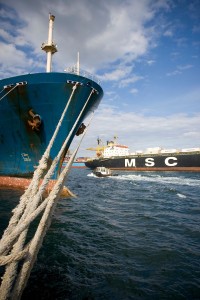Indonesia to Improve Infrastructure, Connectivity
 The Indonesian government launched the Sea Toll Road transportation program, designating 11 seaports to facilitate passenger traffic and 13 to expedite freighting.
One of Indonesia’s greatest challenges has been the lack of inter-island freighter services and inefficient practices in seaports on its over 8,000 inhabited islands. The lack of infrastructure has created logistical problems across the country
The Indonesian government launched the Sea Toll Road transportation program, designating 11 seaports to facilitate passenger traffic and 13 to expedite freighting.
One of Indonesia’s greatest challenges has been the lack of inter-island freighter services and inefficient practices in seaports on its over 8,000 inhabited islands. The lack of infrastructure has created logistical problems across the country
Newly elected President Joko Widodo has stated his intentions to improve Indonesia’s economy by improving infrastructure and opening the nation to world markets. Last year Indonesia’s economy grew only 4.7 percent, the slowest pace since 2009. This growth was lower than those in Vietnam, Malaysia and the Philippines.
Already, major port operations corporations have begun to invest in improving the capacity of major feeder ports. Managing Director of Port Corporation Three Djarwo Surjanto announced that his company would invest up to $1 billion to develop ports that fit international standards.
A Tumultuous Economic Past Indonesia’s poor economic capacity stems from its lack of intra-island connectivity and operational limitations at existing ports. The prices of goods in eastern regions can be 30 times more expensive than the same goods in western regions. Logistical costs amounted to almost a quarter of the country’s $811 billion economy. Cargoes at some ports have a dwelling time of between 4.7 to 6.7 days, and in Semarang it can take 10 days to move containers through the container port. Import disparities make it cheaper to import commodities to Jakarta from China than from Borneo, which is a quarter of the distance.
President Widodo has promised to fix this problem. Upon his victory in the 2014 general elections, Indonesia Investments published an article outlining his “Ambitions, Strategies and Promises.” Widodo promised to focus on the eastern parts of Indonesia, developing heavy infrastructure, and untangling bureaucracies in order to achieve a target GDP growth of 7 percent. He has already begun taking efforts towards this by investing $6 billion into the nation’s ports.
President Widodo: Progress for the Indonesian Economy?
Indonesia is at the forefront of the infrastructure boom. The Sea Toll Road is predicted to “completely upgrade Indonesia’s port network” and is projected to decrease logistical costs by 10 to 15 percent. Widodo has confirmed that the government will spend $429 billion to upgrade infrastructure in the next five years, and by removing gasoline subsidies, he has freed up $18 billion for the 2015 budget.
The Asian Development Bank has created a taskforce to evaluate the feasibility of Widodo’s proposed projects. Deputy Country Director Edimon Ginting, in support of Widodo’s efforts, noted the vitality of “port development” for Indonesia’s “future” for both development and competitiveness.
As noted by the World Bank, connecting “remote regions to the major economic growth poles” would raise living standards. Increasing connectivity is intended to bring together “commodity-rich” outer islands with the manufacturing centers in Java. While President Widodo has been making efforts with high value investments and budget or subsidy cuts, even he has considered that it would still take $450 billion to fix Indonesia’s infrastructure. However, many are hopeful that President Widodo’s presidency will lead to sustained economic growth.
